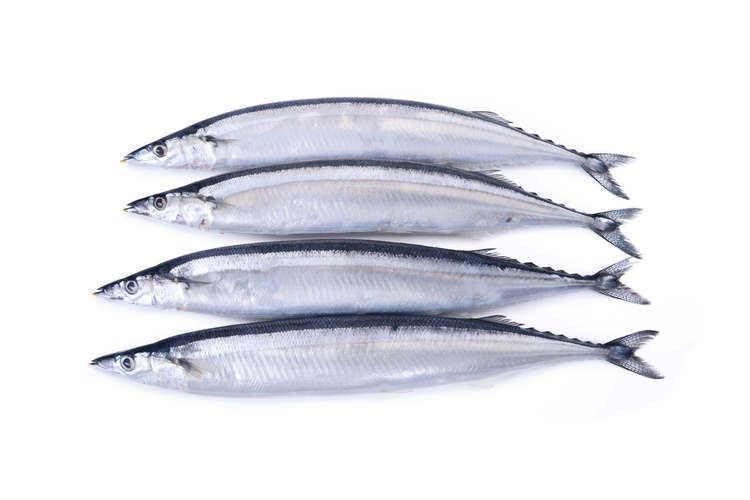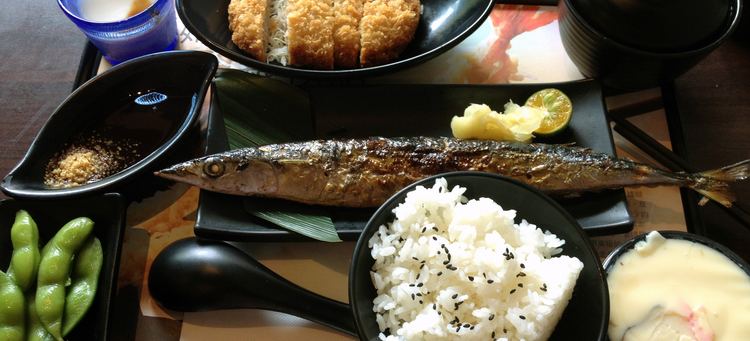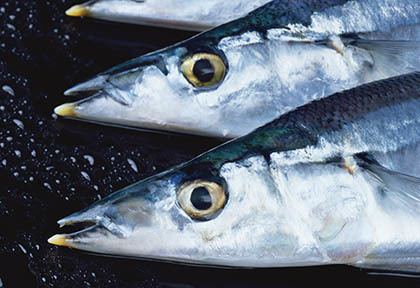Phylum Chordata | ||
 | ||
Similar Kabayaki, Atlantic horse mackerel, Largehead hairtail, Japanese amberjack, Sashimi | ||
Eating japanese food sashimi pacific saury
The Pacific saury (Cololabis saira) is a member of the family Scomberesocidae. This saury, which is a food source in some East Asian cuisines, is also known by the name mackerel pike.
Contents
- Eating japanese food sashimi pacific saury
- Gutting a pacific saury or sanma
- Name
- Appearance
- Biology
- Trade
- Cuisine
- References

Gutting a pacific saury or sanma
Name

It is known as sanma (サンマ / 秋刀魚) in Japanese, 秋刀鱼 (Simplified Chinese) or 秋刀魚 (Traditional Chinese); Pinyin:qiū dāo yú in Chinese, and saira (сайра) in Russian. Pacific saury are often imported to the United Kingdom where they are used as bait for sea fishing. In the UK they are usually called blueys, possibly due to people confusing the Pacific saury with blue mackerel.

The term saira used in its scientific name is the fish's local name in the Kii Peninsula region of Japan.

The Chinese characters used in the Chinese and Japanese names of the fish (秋刀鱼/秋刀魚) literally translate as "autumn knife fish", in reference to its body shape, somewhat resembling a knife, and its peak season.
Appearance
It is a fish with a small mouth, an elongated body, a series of small finlets between the dorsal and anal fins, and a small forked tail. The color of the fish is dark green to blue on the dorsal surface, silvery below, and there are small, bright blue blotches distributed randomly on the sides. The average overall body length of a mature Pacific saury is 25 to 28 cm, and their maximum reported age is four years.
Biology

These pelagic schooling fish are found in the North Pacific, from Japan eastward to the Gulf of Alaska and southward to subtropical Mexico; 67°N – 18°N, 137°E – 108°W, preferring temperatures around 15 – 18 °C. Pacific saury are usually found near the surface (though they may have a depth range of 0 – 230 m), and they are known to glide above the surface of the water when moving away from predators (a behavior that links them to the flying fish, a cousin of the saury family).
The Pacific saury is a highly migratory species. Adults are generally found offshore, near the surface of the ocean, in schools. Juveniles associate with drifting seaweed. Pacific saury are oviparous. Eggs are attached to one another and to floating objects such as seaweed via filaments on the shell surface.
The saury feeds on zooplankton, such as copepods, krill, amphipods, and the eggs and larvae of common fish, such as anchovies, due to their lack of stomach, and their short straight intestines. This is much different from its counterpart the Northern Pike. This is most likely due to the great size difference.
A few of the natural predators of Pacific saury include marine mammals, squid and tuna.
Trade
Pacific saury (often marketed as mackerel pike) are sought after by Chinese, Taiwanese, Russian and Japanese fishermen. This fish has great economic importance where it is found.
Fishing of saury is facilitated by their attraction to light. So, a common way of catching them is to affix powerful lighting fixtures with a number of 500 W blue or white lamps to one side of a boat, and some weaker red lamps to the other. When fish congregate under the stronger white lamps, the lighting is switched to the other side, where the fish – often the whole school – are collected in nets.
Cuisine
Saury, or sanma, is one of the most prominent seasonal foods representing autumn in Japanese cuisine. It is most commonly served salted and grilled (broiled) whole, garnished with daikon oroshi (grated daikon) and served alongside a bowl of rice and a bowl of miso soup. Other condiments may include soy sauce, lime, lemon, or other citrus juices. The intestines are bitter, but many people choose not to gut the fish, as many say its bitterness, balanced by the condiments, is part of the enjoyment. Salt-grilled saury is also served in Korea, where it is known as kongchi gui (꽁치구이).
Sanma sashimi is becoming increasingly available but is not common. Although rarely used for sushi, sanma-zushi is a regional delicacy along parts of the Kii Peninsula, especially along the coast of southern Mie Prefecture. It is prepared by pickling the sanma in salt and vinegar (depending on the region, bitter orange or citron vinegar may be used), and then placing it on top of vinegared rice to create the finished sushi.
The fish can also be pan-fried or canned kabayaki. It is also used for fish meal and pet food in some Western countries.
